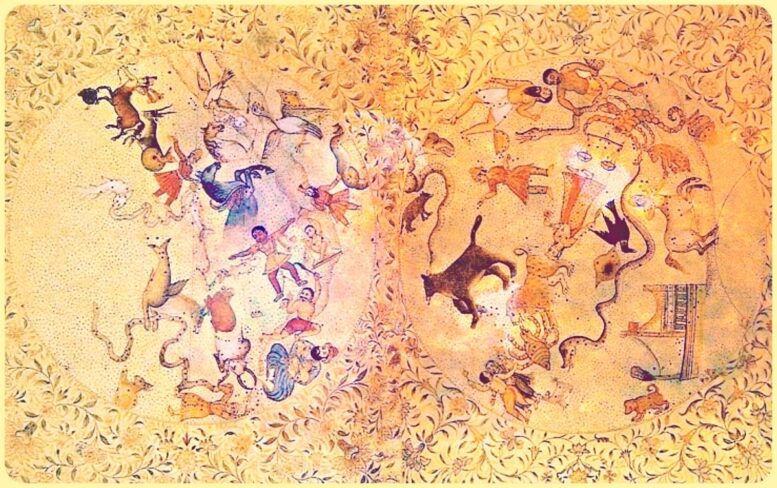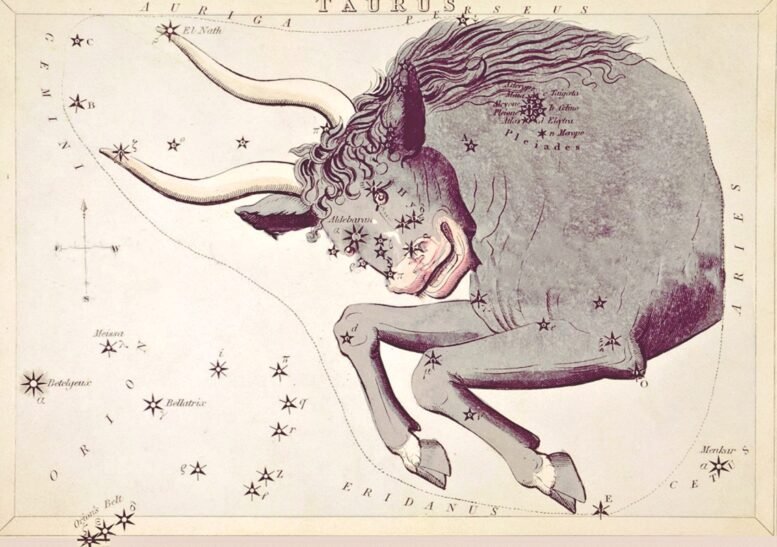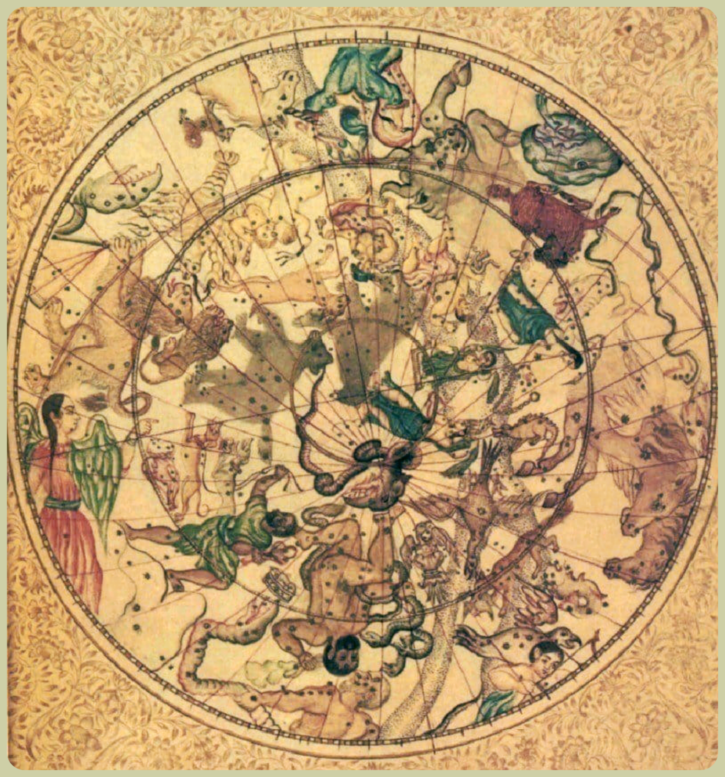Where do you go to, my lovely?
Star light often pairs.
– 10 eternal pairings of Indian mythological characters in the stars.
Eternity is a strange notion, but one that the promise of affection always covets. Naturally, most romantic notions start in the stars, the becoming of the sun and the subsequent reflection of the moon. In that then springs the belief that no grandly loving entity would be denied its consort’s song.
To that inspiration and perspective, we turn into ancient Indian astronomy, and look at some of the oldest star couples in mythology, and the best known to be their respective lover’s love.
Agni – Swaha
Agni – Star Nath, Beta Taurus. The god of fire.
Swaha – Star Zeta Taurus. The holy word offered to the fire.
Agni, the god of fire is attributed several glories to creation and man, and in so, even predominates most of the hymns of the oldest known Indian scripture, the Rig Veda. Swaha, his consort is supposed to be the shape of the offering as the holy word offered to the flame in rituals.
There is a curious story associated to their union set in one of the lunar moon stations, the Nakshatra Krittika (the Krittikas are the Indian version of the Plieades).
Agni, when as a brash young god was besotted with the virtues of the wives of the 7 heavenly sages, the Saptrishis of the Ursa Major constellation. Agni, overwhelmed in unrequited love resolves to set himself ablaze in a forrest of stars and exist no more. Swaha, sister to the 7, herself harbours immense desire for Agni, and catches wind of his designs. She takes her plight to the great lord Shiva (Shiva’s consort Parvati is also Swaha’s sister to scripture). The lord Shiva blesses her and offers her with solution. Swaha, then approaches Agni and proposes that she transform and don herself in her sisters’ likeness in order to satiate his desires. And that her own desire in his acceptance stood sated. Agni, moved at the gesture and touched of its kindness, accepts. Their union commences, and she takes on the avatar of her sisters, one by one in shapeshifting glory. On her part, she is able to guise herself in the form of 6 of her sisters, but not the seventh, known as Arundati, whose sense of devotion is considered penultimate.
A son is born to them, who goes on to be called Skanda, eventually to marshal and lead the heavenly host of armies against darkness.
Incidentally, the Nakshatra or star asterism Krittika is in the shape of a fire flame, testament of Agni’s supernatural glories.
Vasishta – Arundati
Vasishta – Star Mizar, Epilson Ursa Major. One of the 7 sages.
Arundati – Star Alcor, Ursa Major.
The stars of Vasishta and Arundati mark one of heavenly gates in the stars of Indian religion. In fact their names are invoked still in traditional marriage ceremonies in many a part of India. And there is an interesting ritual about them as part of the husband’s beginnings as responsibilities to spouse.
Vasishta and Arundati form a double-star to the eye if seen in the Ursa Major constellation. As part of the ritual, the groom has to point out Vasishta in the sky, and trace Arundati as its twinkling twin. The groom then, upon successfully finding it has to point it out to his bride, enabling her as well to see Vasishta-Arundati twinkling in succession right beside each other in the sky.
Vasishta is one of the Saptrishis, otherwise known as the seven sages, and has several legends associated with him including pivotal arcs in the religious epic Ramayana. Astronomically, his star is a formerly known north pole star of ancient times.
Arundati’s star, Alcor is also called the wandering bird, and perfectly hides behind Vasishta’s star or Epilson Ursa Major. Only upon concentrated focus, a brighter blue emerges from her star, right beside her consort. According to mythology, Arundati was the only one of the Krittikas (Plieades) who did not move her place in the sky when reshuffling of stars happened, but chose instead to stay not just with Vasishta but all seven of the sages to provide anchoring in the sky. As power to her mythological character, Arundati is also associated with the phenomena of the evening, apart from just being a marriage star.
Soma – Saraswati
Soma – Star Castor, Alpha Gemini.
Saraswati – Constellation Lyra, also known as the Veena.
Soma and Saraswati’s love story is a strange one indeed. And one in which most of ancient creation legends of the Indian pantheon converge. Soma as a god becomes part of all the other gods, and Saraswati emerges as the creativity of the entire universe. According to another legend, at the time of the great war of the gods and demi-beings, the Gandharvas, or the celestial musicians kidnapped Soma, and ransomed him back to the gods only if Saraswati was given to them in turn. Saraswati then took another form called Vāc that stayed with the gods, while her former self in creativity merged with the music of the Gandharvas.
In the western pantheon, Castor represents the immortal twin in Gemini who gave up his immortality to his brother Pollux, and their story is considered a reflection of the sun and moon.
Saraswati is known as the goddess of creativity, and is considered one of the most important in the grandest scheme of things. She also had a river to her name that flowed through the Earth as well as the skies of the Milky Way galaxy. When her river dried up (in north-western India) is supposed to be the start of the dark ages of Kaliyuga which are said to exist today.
The Veena or the Lyra as an instrument of music and as a constellation are amongst the oldest known. Vega, the brightest star of the constellation would become the next north star of the Earth in a few thousand years.
Soma is also known as two other forms. The first being the entire Milky Way stream part of the stars in the namesake galaxy, also known as Soma-pavamana, the heavenly stream.
And the other is as the Moon, who is then consorted with 27 lunar moon stations called the Nakshatras. In another legend, the planet Mercury or Budh is born to Soma, in his moon-form of Chandrama.
Agastya – Lopamudra
Agastya – Canopus, Alpha Argo Navis.
Lopamudra – Rho, Dorado.
One of the most enigmatic couples in Ancient Indian history are the sage Agastya and Lopamudra. The star that is Agastya is also known as Māna, meaning the pilot as Canopus of the great ship of the heavens, Argo Navi, the largest constellation in the ancient era. Lopamudra as the star of its consorting accord is also known to be a vanishing star, that after shining brightly for a time disappears completely in intervals. Lopamudra is a rarity as a mythological figure in that she is also a philosopher, considered at par with her more fabled ancient male contemporaries. So much so, a large chunk of hymns in the Rigveda are attributed her authorship. Most of the content curiously is to do with a husband’s responsibilities and expectations from his wife. Nevertheless, she is supposed to have swayed the ancient rishis (sages) with her intellect, and influenced the earliest traditions of coupling.
Agastya for a considerable time in prehistoric eras was the south pole star. Among other achievements to his glory, once drank up the entire waters of the oceans on the Earth. In its consequence was also tasked with guarding the highest abode of the gods(and Indra) at Mount Meru from all mountainous, cloudy and giant threats.
Lopamudra’s disappearance from the sky periodically is linked to still other obscure legends of the Sage Agastya’s apprentices bringing her to him after and upon completion of specified tasks.

Shiva – Parvati
Shiva – Body of the entire universe. Constellation Bootes.
Parvati – The one that becomes the goddess. Spica, Alpha Virgo.
The highest divinities of the Indian pantheon are Shiva and Parvati, which for consciousness become Shiva-Shakti, and for all others, they each transform and bless any manifest from their origin. The story illustrated here is of two of their forms, their relationships gleaned.
Bootes, in Indian astronomy is called Bhūtesā, or Siva-Bhūtesā, the god of the ghostly hosts. And in the western constellation of the rein-holder of the chariot, is also sometimes associated with a sword. Bootes is right beside the Virgo.
The star Spica, the Alpha Virgo is also known as Tara, or Sati. The shape of this star is an irregular Y. Curiously, the Nakshatra Chitra includes this star in a mini-asterism following the same shape. And then the entire Virgo constellation of 33 stars, three times over takes the same irregular Y shape.
This star Sati-tara is also associated with an ancient starburst that birthed the original Sanskrit alphabets of language and merged them with 51 of the oldest known constellations. According to their legend, in her oldest form, Sati was the daughter of a star-creator sage Daksha and was married to the great ascetic god Shiva. And when Shiva is insulted by her father and his party, Sati immolates and sacrifices herself to his honour. When Shiva learns of this, in grief and anger, begins the grandest dance of destruction of the universe, the Tandav, and his force of rage ripples asunder to recreate the heavens to eternity.
Shiva then secures a piece of Sati as Parvati and crowns her as a crescent moon above his brow as perpetual consort.
Varuna – (Akasha-ganga) Varuni
Varuna – Epilson, Ursa Minor.
Varuni – The Milky Way stream of stars.
Among the lesser known gods in the Indian pantheon is this pair. Varuna is supposed to be the god of the waters, and is an Aditya, one of sun’s divine brothers. Varuni, is the name invoked as his consort but traditionally Varuna is set to consort the entire Milky Way stream of stars as his place in the heavens.
The Milky Way stream of stars hangs like soft and shining sheet of thousands of twinkling stars stretching across almost the entirety of sky. The oldest keynotes of creations are set to be concealed in its folds. In its earliest name Via Lactea, it was known in the Indian pantheon as Chhayapath, or the shadow path, and as Somadhara. There are some marvellous legends of how waters from outside the known universe would be led into the Milky Way stream of the galaxy and eventually even down to Earth to replenish the oceans having been dried up to the Sage Agastya’s prowess. Most likely owing to his place in the sky, the star Varuna is accorded the consort of the Milky Way and to be the guiding force of emotion to the galaxy. In his place in the Ursa Minor, along with another star Kochab (Indra), Varuna stands as one of the guardians of the Pole protecting Dhruva, or Polaris the north star from any or every turmoil.
Saraswati – Brahma
Brahma – Auriga, the constellation.
Saraswati – Lyra, the constellation.
This is more a figurehead couple than consorts in the traditional sense. The creator of the universe, Brahma for his place in god hierarchies needs a pair, and for that purpose, the goddess of creativity is seen as paired with the god of creation. A similar grain of legends shows Brahma coupled with Sandhya (Arundati’s maiden avatar), when the great figure of Orion in the sky as Rudra shoots an arrow at Brahma-Sandhya causing several constellations of sky to break apart and stopping Brahma from expanding creation any further. Most likely these pairings are indicative of the earliest alignment of stars when a star-figure called Abhijit (represented as Brahma) was as the first known North Pole star, and Sandhya-Arundati were aligned underneath for balance.
The Saraswati river in ancient India also flowed right beside another early river called Brahma-putra (translating into son of Brahma) merging into each other.
Brahma is said to have had 5 heads enabling him to see all directions. According to yet another legend, one head is cut off, but he has a consort for each head. Sātarupa, Savitri, Saraswati, Gayatri and Brahmani are said to be the 5.
Eventually Brahma started to be looked at as the planet Brihaspati or Jupiter, consorted to star Tara (Spica, Alpha Virgo). But Soma, or the Moon whisked away Tara and their union led to the birth of Mercury called Budh in the Hindu pantheon. This according to yet another legend.
Vāsudeva – Radha
Vāsudeva Krishna – Star Altair, Alpha Aquila.
Radha – Nakshatra Visākha, stars Alpha and Beta of Libra.
No talk of couples in Hindu mythology can ever be complete without the mention of Krishna and Radha. By all virtue, the youngest god of the Indian pantheon, Krishna as a figure in the stars is actually a reworked version of a much more ancient god in the skies as Narayana. In fact Krishna, as a word meant dark, and his adopted mother Yashodhara’s name translates into bestower of resplendence or light. Originally Krishna was representative of a Sun-god, while the sun was yet coming into complete grace. It was then that one of the Nakshatras was known as Radha, otherwise known today as the Nakshatra Visakha. The asterism succeeding it is still called Anuradha to this day (translates into the one after Radha). Such is the figure of Krishna that he always has a peacock feather in his hair. The same peacock feather is represented as the bright colourful lights of the Ursa Major (One of its names in old languages is Chitra-Sikhandi, the peacock’s visage), with Krishna’s crown as the north star or the roof of the world.
In that manner, Krishna’s stories get spread over several stars and constellations that are connected to Vishnu (one of the principle gods), the one Krishna is referred to as the incarnation of. But to origin, Vāsudeva is said to reflect this place in the sky. The name, changed in accent as Vasudeva, and was proffered to Krishna’s father on Earth, with Krishna-Vāsudeva left indicative as Krishna, son of Vasudeva.
Arjuna – Draupadi
Arjuna – Nakshatra Uttara-Phalguni and Purva Phalguni, Leo/Virgo.
Draupadi – Star Zavijara, Beta Virgo.
Amongst the last stars to be named in the skies of Indian astronomy are these, for all study after this era then turned to astrology and the latter was considered a fixed sky.
Arjuna was great hero of the epic ‘Mahabharat’, said to have taken place a few thousand years B.C. He is guided to the victory that becomes the nation, by an incarnated god-form as Krishna and is exceptional in his skill as an archer. Arjuna is also called Phalguna, and two Nakshatras are named after him, both said to the epitome of pairs. This trait of pairing well with others is also something Arjuna is excellent at, with Krishna, Draupadi, his various brothers and yet still others.
Draupadi, is the primary wife of Arjuna, and at his behest agrees to consort him as well as his 4 other brothers. She is seen as the perfect dutiful wife, whose honour and life often come to peril in Arjuna’s many adventures.
Her star is at the navel of the Virgo constellation, and in so is also called the Nabhi-tara. Draupad, her father (the world-tree) is also represented in the stars along with one other of Arjuna’s brothers from the Mahabharata.
Kapota – Kapoti
Kapoti – Constellation Lepus.
Kapota – Constellation Columba.
Although not mythological figures per se, this twining of constellations from the early skies is too precious to avoid mention. Both of these constellations comprise of 8 stars each, and are in similar configurations. Although in western context, Lepus is called the Hare, while Columba, the dove. In Indian astronomy, both are seen as the pairing of stellar doves.
Columba, of course is also called Noah’s dove.
Happy stargazing.
Eternal repair in pairs
Star light often pairs.
A coat of quotes and passing poetry
"
“Tyger Tyger, burning bright,
In the forests of the night;
What immortal hand or eye,
Could frame thy fearful symmetry?
In what distant deeps or skies.
Burnt the fire of thine eyes?
On what wings dare he aspire?
What the hand, dare seize the fire?
And what shoulder, & what art,
Could twist the sinews of thy heart?
And when thy heart began to beat.
What dread hand? & what dread feet?
What the hammer? what the chain,
In what furnace was thy brain?
What the anvil? what dread grasp.
Dare its deadly terrors clasp?
When the stars threw down their spears
And water'd heaven with their tears:
Did he smile his work to see?
Did he who made the Lamb make thee?
Tyger Tyger burning bright,
In the forests of the night:
What immortal hand or eye,
Dare frame thy fearful symmetry?”
- From the Illuminated Manuscript by William Blake.
"Tyger Tyger | William Blake



